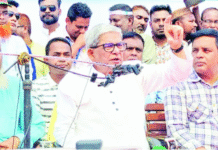Dengue patients exceed 80,000 in hospitals
 The number of dengue patients in the country has exceeded 80,000. While this disease, borne by the Aedes mosquito, has basically been concentrated in Dhaka, it has now spread to the rural areas of the country too. In fact, 44 per cent of the dengue patients are outside of Dhaka.
The number of dengue patients in the country has exceeded 80,000. While this disease, borne by the Aedes mosquito, has basically been concentrated in Dhaka, it has now spread to the rural areas of the country too. In fact, 44 per cent of the dengue patients are outside of Dhaka.
While the number of dengue patients has somewhat decreased this month as compared to August, this has increased in certain districts outside Dhaka. Concerned government officials say it is difficult to control mosquitoes in the villages.
According to official records, till Friday 80,040 patients were admitted to hospital with dengue this year. Of them, 35,373 were outside of Dhaka. This is an unprecedented number of patents to be admitted to hospital with dengue in the country. So far 76,936 dengue patients have been released from hospital upon completion of treatment.
In the year 2000, there was an outbreak of dengue in Bangladesh and it reached a peak of 10,248 patients being admitted to hospital in 2018. However, this year in August alone 52,636 dengue patients were hospitalised.
Over the past few years it has been observed that dengue normally prevails from April to mid-October every year, peaking in September. This year, however, there had been a decrease in dengue from August, though the numbers still exceed that of preceding years. Last year an average of 100 patients were admitted to hospitals every year, but in September this year the number has exceeded 600 so far. Of the 672 patients admitted to hospitals on Friday, 444 were outside of Dhaka.
Speaking to Prothom Alo over mobile phone on Friday, Jashore civil surgeon Dilip Roy said the situation was not good there. On Friday 90 new dengue patients were admitted to public and private hospitals in the district.
So far 2077 dengue patients have been admitted to hospital in Jessore this year. On Friday there were a total of 251 hospitalised dengue patients in the district. Civil surgeon Dilip Roy said that most of the patients come from villages of Keshabpur, Manirampur, Bagharpara and Chaugachha upazilas and are mostly between 20 to 50 years old. The majority of them were infected by mosquitoes in their workplaces.
The civil surgeon went on to say that the spread of mosquitoes and dengue has lessened in Jessore town due to the cleanliness and anti-mosquito drive, but it was difficult to eliminate mosquitoes in the villages. Many of the people refuse to destroy their banana and taro plantations where mosquitoes breed.
The Kushtia district administration and civil surgeon’s office reported that dengue had spread to at least 30 villages of the district. Fogger machines were being used to spray insecticide in and around the areas, but to no avail. In Darpara of Daulatpur alone, 60 dengue patients have been recorded so far.
Bheramara upazila nirbahi officer Sohel Maruf has said, “All the village homesteads have cows and water accumulates near the cowsheds. Water also gathers at the taro and banana plantations.” He said some people also did not use mosquito nets.
On Friday, 96 dengue patients were admitted to Sher-e-Bangla Medical College Hospital in Barisal. Of them, 23 patients spoke to the Prothom Alo correspondent, revealing that 18 had been infected locally and five had been in Dhaka.
Over the past three weeks the number of dengue patients outside of Dhaka has increased. So far it had been the Aedes aegypti species of mosquito that had carried the dengue virus in the cities, but now the Aedes albopictus variety has appeared to be carrying the virus too, according to a survey carried out in Barisal, Kushtia and Meherpur by the government’s Institute of Epidemiology , Disease Control and Research (IEDCR).
According a study of 28,161 patients by IEDCR, 37 per cent of the dengue patients in the country are female and 63 per cent male. Another study of the institute estimated that 32 per cent of the patients were below 18 years of age.
Reports received by IEDCR state that till Friday, 203 patients have died of dengue this year. However, Prothom Alo puts this figure at 215, based on information provided by the patients’ families, the district civil surgeons and hospital authorities.









